In the winter season, when all the flowers are in a dormant phase, the window sills are decorated with a flowering Decembrist or Christmas tree. This plant has an attractive appearance and beautiful bright flowers. In addition, the flower is often called the cervical neck due to the presence of leaves of an unusual shape.
Few people know that the Decembrist belongs to the genus of epiphytic cacti, and is correctly called Schlumberger. But caring for it is slightly different from the content of prickly plants. In order for the Decembrist to bloom beautifully at home, it is necessary for him take care and multiply. The flower itself belongs to long-lived plants and can live for more than 20 years.
Content
Features indoor Decembrist
The plant has a short woody stem and segmental leaves, which consist of elongated parts with wavy or jagged edges, as well as fleshy bright green leaves. The flowers are funnel-shaped and can be of different colors. Buds are formed at the ends of jointed leaves.
The birthplace of the Decembrist is the southern part of America, where the plant blooms in the summer. At home, hybrids of this species grow, which begin to bloom in mid-December, and, subject to all recommendations, can bloom twice a year. In addition, every year there are more and more hybrids with two-color buds. The plant itself is quite large and reaches large sizes. In its natural habitat, a flower grows on trees, so its leaves and flowers are directed downward.
The Decembrist has three subspecies - the truncated Schlumberger, Gertner and Buckley. Truncated differs in long leaves-segments, as well as flowers with curved outward edges. Gertner's subspecies has bright orange buds with sharp petals at the ends. Schlumbergera Buckley captivates with his purple flowering and segments with protrusions along the edges.
Decembrist propagation by cuttings at home
There are several ways to reproduce Decembrist:
- cuttings;
- by seeds;
- grafting parts to the plant.
You can use any, but the first is considered the easiest. Even beginners can use this method.
Preparation of cuttings for propagation, rooting
After the process is selected, it is necessary to gently pinch it off with your hands and twist it in circular movements. With the second hand, you need to hold it so as not to damage it. It is highly recommended not to cut the stalk with scissors or a knife, as it can be easily damaged.

The resulting young plant is placed in a dry, dark place. This is necessary so that a film forms on it in the place where the baby was torn off. The appearance of the film indicates the readiness of the Decembrist for landing. In addition, it can be sprinkled with chopped charcoal to prevent the entry of microorganisms.

Rooting a plant is carried out in water or in a substrate. To do this, the process is planted in a small container with soil in which it is immersed halfway. The cuttings are covered with a glass or bag and grown on the windowsill to root.About a month later, the rooting of the plant occurs, and it can be transplanted into a constant capacity in the presence of 3-4 large leaves.
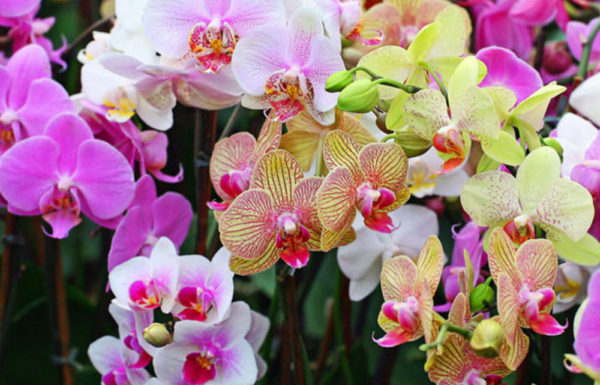 You may be interested in:
You may be interested in:Planting cuttings in the ground
Before planting, you must take care of the readiness of the soil. So, you can buy a ready-made substrate in the store. It is necessary to choose land for cacti, so that the acidity values are in the range from 5.5 to 6.5.
However, you can prepare the soil yourself. To do this, you need turf land, peat, sand, humus and leaf land in a ratio of 1: 2: 2: 4: 6. Some gardeners grow plants only in peat, as it accelerates the growth and flowering of the Christmas tree. It is very important that the earth passes air well and is light. Also in the pot for planting must have drainage holes.

After the land is prepared, you must select a capacity for planting. It should be small in size, since the plant has an unbranched root system, and too large a pot can contribute to its decay.
A thick layer of drainage is placed at the bottom of the container, which is covered with a substrate on top. They make a small hole in it and plant a young plant. If several cuttings were prepared, then several pits are also made. If there is still no permanent flowerpot, then the processes can be planted in glasses or jars for a while.
Growing in water
Also, Decembrists can be propagated by cuttings that germinate in water, and not in the substrate. To do this, warm water is collected in the tank and only half the processes are immersed there. Over time, the water evaporates, so it must be periodically added.
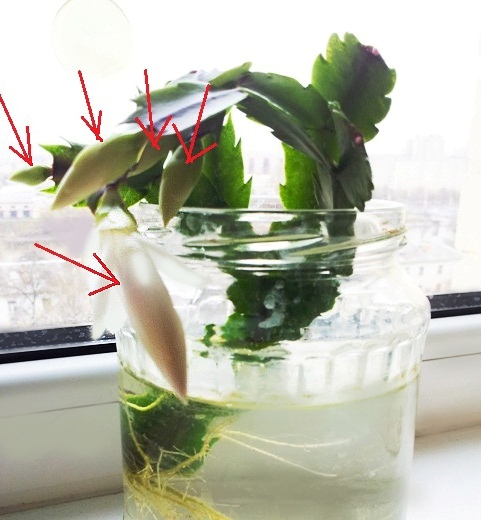
Some gardeners say that water can turn yellow with sediment over time. This means that the water has deteriorated and needs to be changed. To do this, pour out the liquid, wash the container, and the young plant is washed gently and again immersed in water.
A few weeks later, the Decembrist begins to take root and thin white roots appear on its stem. It is during this period that it can be transplanted into a substrate in a permanent place.
Features of the propagation of Decembrist leaf
First of all, it is necessary to determine the breeding time. The most favorable is considered the beginning of April and the end of May during the period when the plant has already blossomed and is in a dormant phase. However, experts say that you can propagate a flower with a leaf at any time of the year, and it will also grow. Be sure to ensure that this happens after flowering, so that the transplant does not affect the condition of an adult Decembrist.
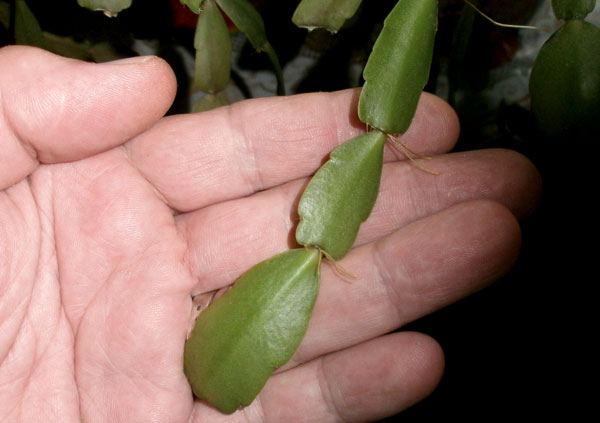
After this, you need to pay attention to the choice of the handle itself. An ideal stalk should be without any damage, not wilted and should consist of at least 3 parts. For such purposes, the shoot is already selected with roots. In order to obtain a large plant in the future, it is necessary to take several cuttings. Experienced flower growers also recommend that children be selected in places of their abundant growth, as more processes will appear in their place.
After the stalk is separated, it is necessary to sprinkle the place of separation on the mother plant with charcoal in order to prevent the ingress of microorganisms.
Other methods of breeding a houseplant at home
In addition to grafting, seed reproduction and grafting are also used. These methods are used very rarely, since they are quite complex and not within the power of some gardeners.
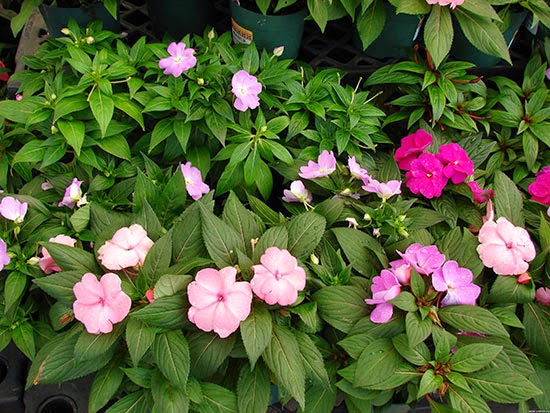 You may be interested in:
You may be interested in:Seeds
Basically, seed propagation is used to maintain a pure plant culture, and at home it is a rather troublesome task. The most laborious is the extraction of the seeds themselves. Since the seeds are formed as a result of pollination, therefore, several identical plants must stand in the room in order for pollination to occur.
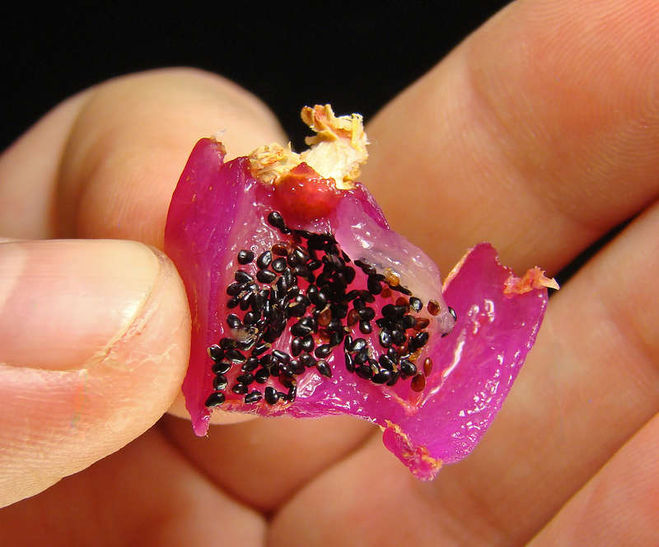
In place of the flower, a small box is formed in which the seeds are contained. They ripen for about six months, after which they can be used for sowing. After the seeds are collected, they are washed in potassium permanganate and allowed to dry. Sown in a small container with the substrate in a linear direction. After the seeds germinate, they can be transplanted into a permanent pot. Young plants need to be cut every 3 months.
Graft
In order to vaccinate, you must choose the plant that will be vaccinated. It can be prickly pear or prickly peresia. On the selected flower, cut off the upper part of the stem about 10-15 cm and clean it of leaves. After that, a shallow oblique incision is made on its upper part.
At a Christmas tree, a sheet of several parts is selected. The lower part is slightly narrowed with a knife and inserted into a previously cut stalk. The place of vaccination must be supported with a needle and secured with a band-aid. Vaccination occurs after a few weeks.
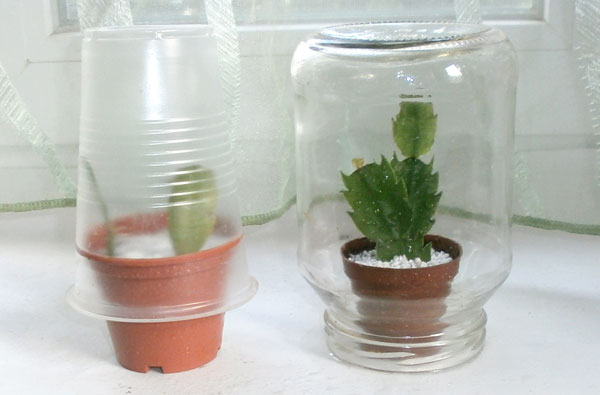
To do this, it is very important to provide the plant with a temperature of + 18-20 degrees in the room. As soon as the flower begins to grow actively, the bandage can be removed so that the plant has enough strength. The flowering of such a grafted Decembrist can be seen in the coming winter.
Caring for a young Decembrist at home
In order for a flower to please its beauty, it is necessary to provide it with a large amount of light, as well as moisture and heat. Since the Decembrist is not active in warm weather, it can be located on the north side. In winter, it needs to be placed on windows on the south side, where there is more light. Experts recommend moving the cactus every month, exposing the light to different sides so that it grows evenly.

Watering should be regular and during flowering, their number should increase. In addition, you can use only warm filtered water, since cold running water can lead to decay of the root system. Fertilizers are applied monthly during the flowering period, and twice during the dormant period.
To maintain a high level of moisture, the Decembrist is sprayed with warm water and bathed in the shower every 7-10 days. When bathing in the shower, it is necessary to cover the soil so as not to provoke rotting of the root system.
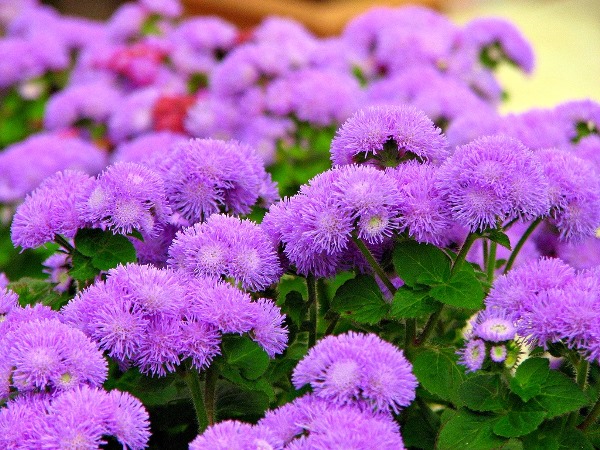 You may be interested in:
You may be interested in:Possible growing problems and methods for solving them
Immediately after transplanting the young Decembrist, some problems with his growth may appear. So, the most common is the wilting of the whole flower. Most often this is due to the development of the disease, which could appear at the time of weaning of the cuttings from the mother plant. It can also be triggered by the decay of the root system itself, which often occurs due to excessive watering and improperly selected substrate.
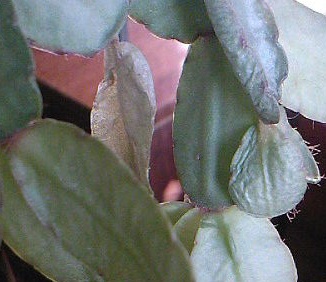
Irritation of the stem can result from irrigation with cold running water and excessive fertilizer application.In order to eliminate such a problem, it is necessary to remove the plant from the pot, cut the damaged areas and plant the flower in new soil. With the death of the entire root system, cuttings are cut from the flower for propagation.
Florists often complain that the Decembrist does not bloom. This may be due not only to insufficient care, but also to the onset of a dormant period. This occurs when there is no rest before bud formation. During the dormant period, which lasts from September to the beginning of winter, watering and top dressing are removed, and the pot is rearranged in a cool, darkened place. At the end of autumn, the pot is again placed in a warm place and gradually all the care is restored.
Many gardeners, especially beginners, can be frightened by a sharp fall of Christmas leaves due to infection by a tick (insecticides are used for treatment). The leaves also fall off due to the presence of a flower in a draft, with sharp jumps in temperature, dry air and insufficient fertilizer. In such cases, it is very important to establish the cause of the problem and eliminate it.
Common questions
Decembrist is an unusual flower that pleases flowering in the winter season. Propagating such a plant is not difficult. For this, the method of propagation by cuttings is most often used, which is available even to beginner growers.

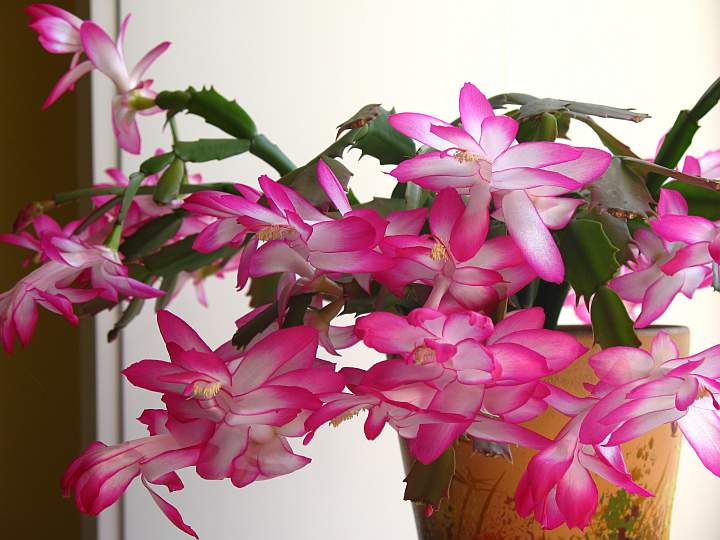





 Sow in the ground, without seedlings: 10 beautiful and unpretentious flowers
Sow in the ground, without seedlings: 10 beautiful and unpretentious flowers Platicodon planting and outdoor care
Platicodon planting and outdoor care Hosta - planting and care in the open ground in the Urals
Hosta - planting and care in the open ground in the Urals Oleander - care and growing at home
Oleander - care and growing at home